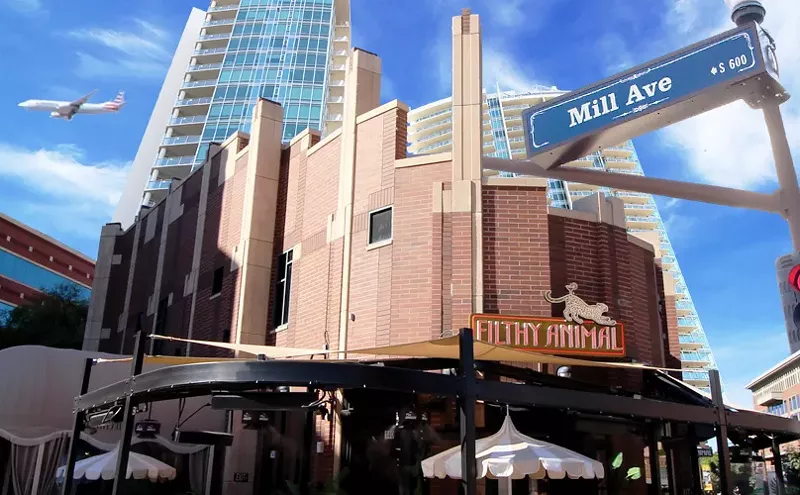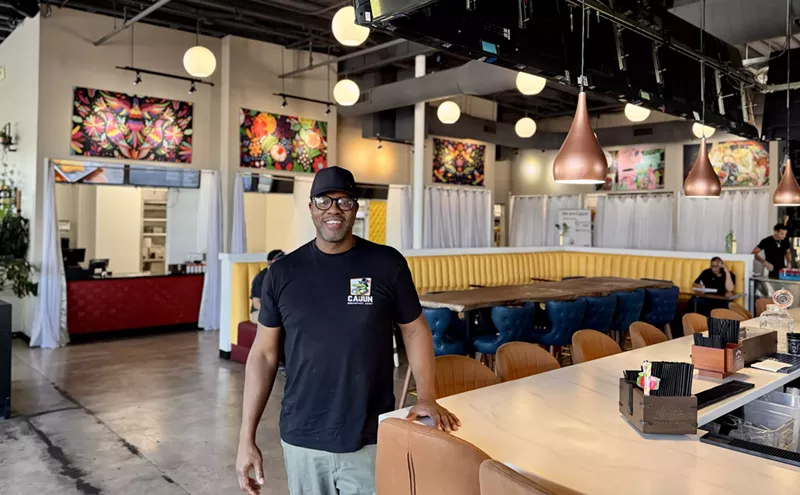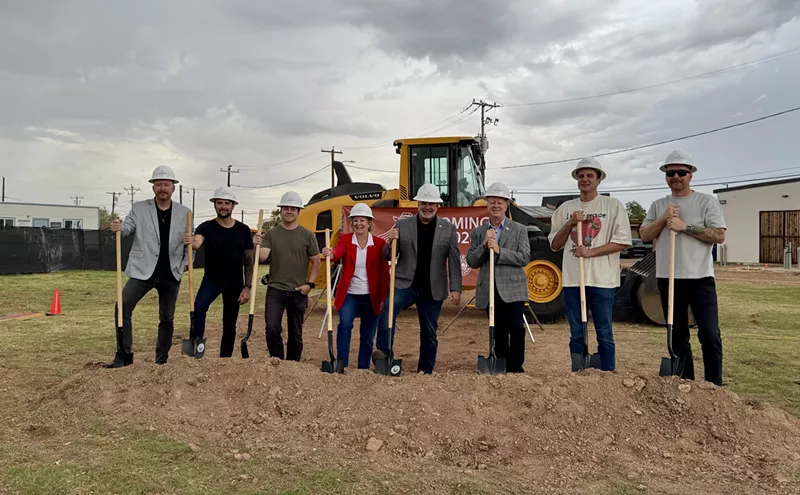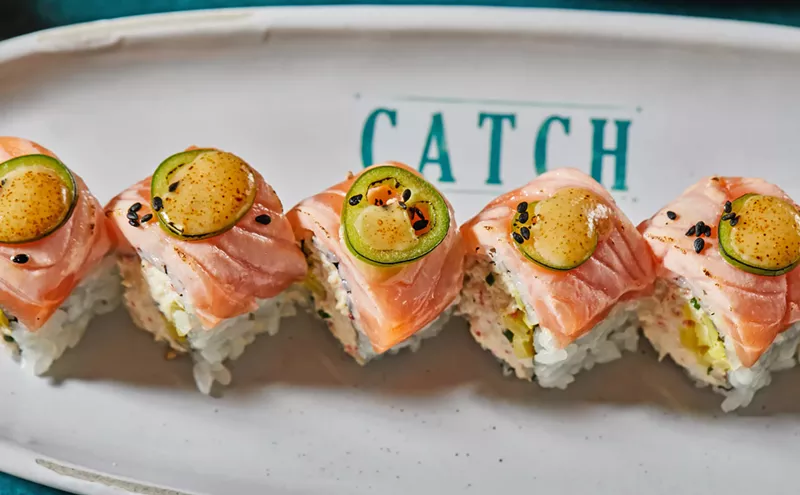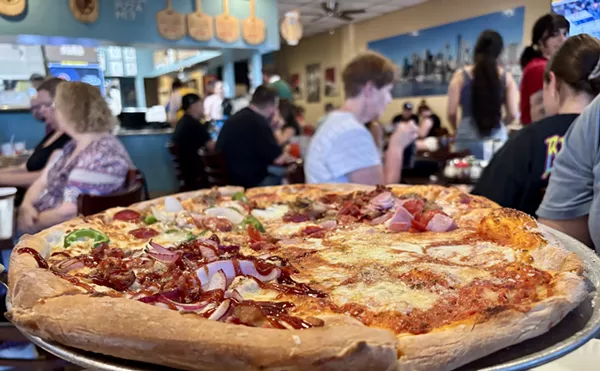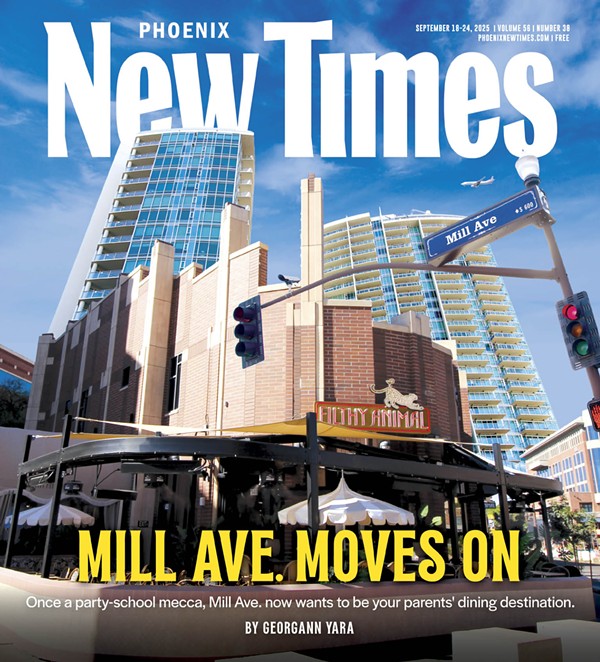Update: This story has been updated to reflect additional information provided by Recreo. A representative from the restaurant says notices disclosing the credit card fee were posted online and on menus. The restaurant has since removed the fee.
When Paul Schommer received his bill after dining at Recreo, a downtown Chandler eatery known for its playful indoor-outdoor space and Mexican-inspired menu, he was surprised to find a 3.5% service charge added due to “industry conditions.”
It caught him off guard because he wasn’t aware of the fee until he saw the fine print at the bottom of his check. He posted a photo of his receipt to Yelp along with a three-star review of the restaurant.
Recreo has since phased out the additional charge, but when Schommer dined there in February, he says he didn't see any indication of the fee until he got his receipt. A representative from Recreo says notices were posted online and on menus in addition to receipts.
Schommer is familiar with the restaurant industry. He owned Pitta Souvli Mediterranean Grill, just southwest of downtown Chandler, for nearly eight years. He is empathic to the volatility of restaurant ownership, particularly over the past few years as restaurants have navigated the pandemic, soaring costs, increasing minimum wages and staffing challenges. But, he was floored that a restaurant would pass along the cost of doing business to its customers.
“You build that into the price of running your business,” Schommer says, noting he would adjust menu prices as needed at his restaurant to absorb some of those challenges. “Every business pays those credit card processing fees.”
Schommer is not alone in his frustration. Diners from around the country have posted receipts with surprise fees to social media that have gone viral.
Restaurants that don’t do enough to inform guests about these fees are seeing pushback, and not just in the form of negative reviews. In May, two Scottsdale restaurants — steakhouse Maple & Ash and wood-fired grill Etta – were each hit with a $10,000 penalty for failing to properly disclose a 3.5% service fee.
These added charges, which can cover everything from general operations to employee benefits, are less common in the Valley than in many other cities around the country. Arizona Restaurant Association President and CEO Steve Chucri estimates that fewer than 5% of Arizona restaurants employ them, but he says that number is growing. The National Restaurant Association estimates that 15% of restaurants now charge these fees nationwide.
Should diners expect service fees to take hold in the Valley? It depends on who you ask. While most customers and experts share their displeasure with the added costs, restaurant and bar owners point to ongoing challenges and say a fee is their best option. One thing both sides can agree on is the need for service fees to be advertised more openly.
When it comes to decoding added fees, it’s important to note they are not tips. Automatic tipping fees, which are commonplace in Europe, have had fits and starts in gaining traction in the U.S. but have never taken hold as the norm. Those generally range from 18% to 22% and are most common when dining with a large group or hosting a private event, at which time no additional gratuity is expected.
Other fees, which can be called service fees, service charges or employee benefit fees, generally hover in the 3.5% to 5% range. Because they’re not considered a tip, these dollars go to restaurant owners.
“That gives them the ability to do whatever the hell they want with that money,” says Tracy Miller, an employment law attorney with Scottsdale’s Ogletree Deakins.
That can mean covering the costs of doing business, such as paying credit card processing fees, increasing employees’ hourly pay or providing employee benefits or support. The classifications are general and, as a result, can be confusing to diners and murky for employees.

When fees become fraud
Maple & Ash and Etta settled for $20,000 with the Arizona Attorney General’s Office in May for failing to properly disclose a 3.5% charge to diners. The office noted disclosure of the charge, which covers “health insurance, benefits and staff wellness,” was only found on restaurants’ “About Us” pages on their websites and at the bottom of the online reservation pages.
Those attempts at disclosure, the attorney general’s office said, were not adequate and amounted to consumer fraud.
"Defendants created a separate charge that appeared mandatory and allowed defendants to advertise lower menu prices while knowing they would charge higher prices on the final bill," according to the lawsuit. "Defendants then concealed, suppressed or omitted material information about that charge on the menu, over the phone and on their websites.”
Once sister restaurants of the same Chicago-based hospitality group, Etta and Maple & Ash have since split. Etta’s new management has done away with the employee benefit fee. Maple & Ash continues to charge the fee, but it is now disclosed on the menu.
“The public deserves transparency when dining out, and that includes knowing the total cost of meals before ordering,” Arizona Attorney General Kris Mayes said in a press release. “This settlement sends a clear message to restaurants that they must disclose all add-on charges on their menus, so customers can make informed decisions.”
Finding fees
To avoid confusion, the Barter & Shake Cocktail Entertainment team — which runs the immersive bars Platform 18, Grey Hen Rx and UnderTow, in Phoenix and Gilbert — puts its 4% staff benefit fee out for all to see. That starts with including it on online reservations pages, as 88% of guests book their experience in advance, according to Mat Snapp, Barter & Shake’s executive vice president of operations.
“A lot of the noise is that people think that employers and businesses are trying to be super shady. I feel proud to say we’re doing our best to be the opposite,” Snapp says. “We’re trying to be sunny as opposed to shady.”
Born & Raised Hospitality, the team behind such restaurants as Clever Koi, Across the Pond and Fellow Osteria, decided to implement a 3.5% fee in December to increase pay for staff. Representatives from both Barter & Shake and Born & Raised point to their attempts to notify their customers in as many places as possible — on their website, on menus and on bills — to avoid surprising customers or putting their staff in an awkward position.
“We try to be as transparent as possible,” says Born & Raised co-founder and co-owner Joshua James. “We wanted to differentiate ourselves from the way some other restaurant groups have done it thus far.”
Arizona Restaurant Association's Chucri agrees that proper disclosure is critical for restaurants and bars that decide to implement fees. But, there are still inevitable questions from guests. He says customers should feel comfortable asking for any clarification about items on their bills.
“If you have a question, simply ask about it,” he says. “As a guest, you have every right to ask.”
Alexandria Downing, bar manager at Grey Hen, says she hasn’t had to handle a customer question about the service fee yet, but she has made sure she is well-versed in it well in case concerns come up. The Barter & Shake team offers training to ensure staff understand their benefits and are able to answer customer questions, she says.
“We all know what to do when those types of things arise. The last thing anyone would want is for that question to be asked and you not have an answer for it, because that’s what makes it look sketchy,” Downing says. “We do take the time to make sure everyone is fully aware of what it is, how we talk about it and essentially, how to explain it to guests."
Independent human resources consultant Lyndsey Hanna says that disclosing these fees shouldn’t fall on front-line staff — and that owners should notify guests in as many places as possible, including online, on the menu and on signage at the restaurant or bar.
“It is not the responsibility of a server, or any other restaurant staff, to notify a guest regarding an unexpected increase to their final check,” she said in an email. “If an owner worries they won't get business if it's openly disclosed, I ask them to question why they are doing it in the first place.”
Should a customer disagree with the fee, both Snapp and James note that they can ask to have it removed from their tab.
Experts share skepticism
Chucri says he tries to dissuade restaurants and bars from adopting fees and instead encourages them to partner with the association to find other cost savings in their business.
With the razor-thin, single-digit profit margins food and beverage owners face, Chucri says he understands the challenges but notes that restaurateurs must also recognize the frustration of customers who are feeling the growing costs of going out, as well as tipping fatigue.
Attorney Miller and Hanna say they likewise try to deter clients from implementing these fees.
“Additional fees, plus the expectation of a gratuity for staff, puts customers in an uncomfortable position,” Hanna said. “Are those extra few dollars in fees really worth negative customer reviews, loss of return customers and losing valuable staff? From an HR perspective, absolutely not.”
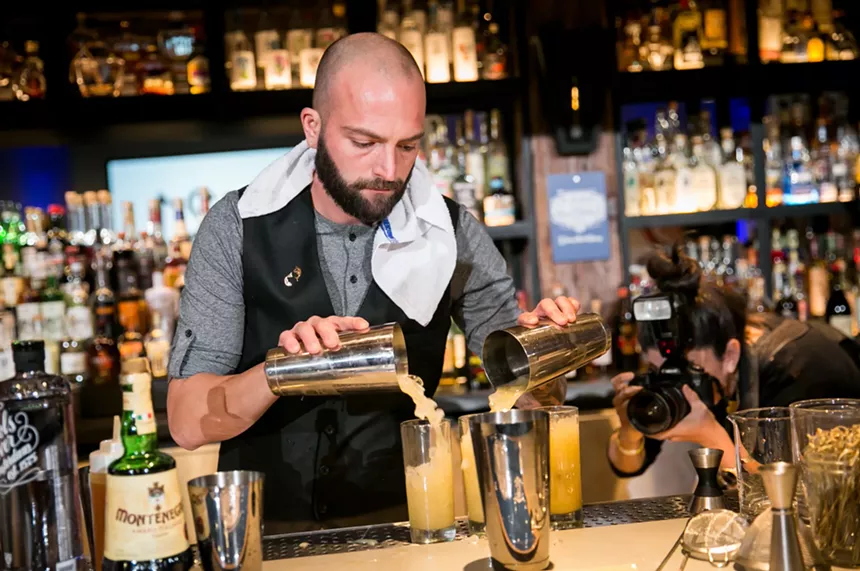
Closing gaps for employees
Clever Koi’s James disagreed, saying the fee at his restaurants has been met with positivity from customers and staff. The charge has already allowed his hospitality group to raise salaries for cooks and other back-of-house staff by $4 to $5 an hour — an effort to close a historic pay gap and start new staff at higher wages, he says.
“We’ve seen a really positive return as far as retention and overall mental health across the restaurants, especially in the back of the house,” he says, noting that prior to implementing the fee and making changes to pay, finding reliable employees was a challenge.
For the Barter & Shake team, the proceeds from the service fee have allowed the company to provide health and retirement benefits for full-time employees — something that isn’t required due to the company’s small size but makes a world of difference for holding onto employees, Snapp says.
Downing says she never had a strong opinion about service fees but adds that as someone who knows the ups and downs of the industry after nearly nine years bartending, she’s become more aware and understanding of those charges. The Tucson native previously worked at Fox Restaurant Concepts, most recently bartending at Culinary Dropout in Scottsdale Quarter and training bar staff at new Fox restaurants. She has been bar manager at Grey Hen since November, and she just set up her first retirement savings account.
“They’ve got us really set up over here to be doing what we do as a career and actually being able to live off of what we do,” she said of the benefits she receives.
While industry leaders may get the nuances of service fees — and how those fees have expanded in communities outside of Arizona — they're still relatively new, bewildering and frustrating for many Valley customers.
“Part of what people are concerned about is it feels like a trick. It’s confusing the customer,” says Miller, who advises businesses on labor and employment law.
So why not raise menu prices? Snapp and James say their teams both considered increasing menu prices, but felt that a fee would offer the most flexibility, transparency and ultimately pass along a lower cost increase to customers than if they upped prices.
“It’s easier to expand than it is to contract,” James says. “I don’t want to get into the business of consistently raising, raising, raising our prices. I’ve yet to see a restaurant group raise their prices and bring them back.”
Snapp says a fee helps the company provide more benefits to staff while being upfront with customers and still letting them decide how to dole out gratuity.
“The art of gratuity is still your own prerogative,” Snapp says. “I would much rather guarantee the benefits that we’re giving to our team than have them rely on the generosity of strangers.”
Are fees the future in the Valley?
James says he’s hopeful the fee at his restaurants can be temporary.
“We hope it doesn’t become a long-term thing and that prices level out,” he says.
As he looks at other states, he sees the dilemma restaurant owners are in. He recalls a recent visit to San Diego, where he noticed a 13% service charge on one tab.
“That was eye-opening,” he says. “It’s the nature of the beast.”
Snapp agreed that as these charges become more commonplace in other cities around the country, they will in Phoenix as well.
“I think that it’s coming to the Valley,” he says. “It shows the growth of Phoenix not only from a population standpoint but also from a food and beverage standpoint.”
****
It caught him off guard because he wasn’t aware of the fee until he saw the fine print at the bottom of his check. He posted a photo of his receipt to Yelp along with a three-star review of the restaurant.
Recreo has since phased out the additional charge, but when Schommer dined there in February, he says he didn't see any indication of the fee until he got his receipt. A representative from Recreo says notices were posted online and on menus in addition to receipts.
Schommer is familiar with the restaurant industry. He owned Pitta Souvli Mediterranean Grill, just southwest of downtown Chandler, for nearly eight years. He is empathic to the volatility of restaurant ownership, particularly over the past few years as restaurants have navigated the pandemic, soaring costs, increasing minimum wages and staffing challenges. But, he was floored that a restaurant would pass along the cost of doing business to its customers.
“You build that into the price of running your business,” Schommer says, noting he would adjust menu prices as needed at his restaurant to absorb some of those challenges. “Every business pays those credit card processing fees.”
Schommer is not alone in his frustration. Diners from around the country have posted receipts with surprise fees to social media that have gone viral.
Restaurants that don’t do enough to inform guests about these fees are seeing pushback, and not just in the form of negative reviews. In May, two Scottsdale restaurants — steakhouse Maple & Ash and wood-fired grill Etta – were each hit with a $10,000 penalty for failing to properly disclose a 3.5% service fee.
These added charges, which can cover everything from general operations to employee benefits, are less common in the Valley than in many other cities around the country. Arizona Restaurant Association President and CEO Steve Chucri estimates that fewer than 5% of Arizona restaurants employ them, but he says that number is growing. The National Restaurant Association estimates that 15% of restaurants now charge these fees nationwide.
Should diners expect service fees to take hold in the Valley? It depends on who you ask. While most customers and experts share their displeasure with the added costs, restaurant and bar owners point to ongoing challenges and say a fee is their best option. One thing both sides can agree on is the need for service fees to be advertised more openly.
Decoding dining fees
When it comes to decoding added fees, it’s important to note they are not tips. Automatic tipping fees, which are commonplace in Europe, have had fits and starts in gaining traction in the U.S. but have never taken hold as the norm. Those generally range from 18% to 22% and are most common when dining with a large group or hosting a private event, at which time no additional gratuity is expected. Other fees, which can be called service fees, service charges or employee benefit fees, generally hover in the 3.5% to 5% range. Because they’re not considered a tip, these dollars go to restaurant owners.
“That gives them the ability to do whatever the hell they want with that money,” says Tracy Miller, an employment law attorney with Scottsdale’s Ogletree Deakins.
That can mean covering the costs of doing business, such as paying credit card processing fees, increasing employees’ hourly pay or providing employee benefits or support. The classifications are general and, as a result, can be confusing to diners and murky for employees.

Maple & Ash and Etta (pictured) agreed to pay $20,000 in fines after the restaurants were accused of defrauding customers.
What If Syndicate
When fees become fraud
Maple & Ash and Etta settled for $20,000 with the Arizona Attorney General’s Office in May for failing to properly disclose a 3.5% charge to diners. The office noted disclosure of the charge, which covers “health insurance, benefits and staff wellness,” was only found on restaurants’ “About Us” pages on their websites and at the bottom of the online reservation pages. Those attempts at disclosure, the attorney general’s office said, were not adequate and amounted to consumer fraud.
"Defendants created a separate charge that appeared mandatory and allowed defendants to advertise lower menu prices while knowing they would charge higher prices on the final bill," according to the lawsuit. "Defendants then concealed, suppressed or omitted material information about that charge on the menu, over the phone and on their websites.”
Once sister restaurants of the same Chicago-based hospitality group, Etta and Maple & Ash have since split. Etta’s new management has done away with the employee benefit fee. Maple & Ash continues to charge the fee, but it is now disclosed on the menu.
“The public deserves transparency when dining out, and that includes knowing the total cost of meals before ordering,” Arizona Attorney General Kris Mayes said in a press release. “This settlement sends a clear message to restaurants that they must disclose all add-on charges on their menus, so customers can make informed decisions.”
Finding fees
To avoid confusion, the Barter & Shake Cocktail Entertainment team — which runs the immersive bars Platform 18, Grey Hen Rx and UnderTow, in Phoenix and Gilbert — puts its 4% staff benefit fee out for all to see. That starts with including it on online reservations pages, as 88% of guests book their experience in advance, according to Mat Snapp, Barter & Shake’s executive vice president of operations. “A lot of the noise is that people think that employers and businesses are trying to be super shady. I feel proud to say we’re doing our best to be the opposite,” Snapp says. “We’re trying to be sunny as opposed to shady.”
Born & Raised Hospitality, the team behind such restaurants as Clever Koi, Across the Pond and Fellow Osteria, decided to implement a 3.5% fee in December to increase pay for staff. Representatives from both Barter & Shake and Born & Raised point to their attempts to notify their customers in as many places as possible — on their website, on menus and on bills — to avoid surprising customers or putting their staff in an awkward position.
“We try to be as transparent as possible,” says Born & Raised co-founder and co-owner Joshua James. “We wanted to differentiate ourselves from the way some other restaurant groups have done it thus far.”
Arizona Restaurant Association's Chucri agrees that proper disclosure is critical for restaurants and bars that decide to implement fees. But, there are still inevitable questions from guests. He says customers should feel comfortable asking for any clarification about items on their bills.
“If you have a question, simply ask about it,” he says. “As a guest, you have every right to ask.”
Alexandria Downing, bar manager at Grey Hen, says she hasn’t had to handle a customer question about the service fee yet, but she has made sure she is well-versed in it well in case concerns come up. The Barter & Shake team offers training to ensure staff understand their benefits and are able to answer customer questions, she says.
“We all know what to do when those types of things arise. The last thing anyone would want is for that question to be asked and you not have an answer for it, because that’s what makes it look sketchy,” Downing says. “We do take the time to make sure everyone is fully aware of what it is, how we talk about it and essentially, how to explain it to guests."
Independent human resources consultant Lyndsey Hanna says that disclosing these fees shouldn’t fall on front-line staff — and that owners should notify guests in as many places as possible, including online, on the menu and on signage at the restaurant or bar.
“It is not the responsibility of a server, or any other restaurant staff, to notify a guest regarding an unexpected increase to their final check,” she said in an email. “If an owner worries they won't get business if it's openly disclosed, I ask them to question why they are doing it in the first place.”
Should a customer disagree with the fee, both Snapp and James note that they can ask to have it removed from their tab.
Experts share skepticism
Chucri says he tries to dissuade restaurants and bars from adopting fees and instead encourages them to partner with the association to find other cost savings in their business. With the razor-thin, single-digit profit margins food and beverage owners face, Chucri says he understands the challenges but notes that restaurateurs must also recognize the frustration of customers who are feeling the growing costs of going out, as well as tipping fatigue.
Attorney Miller and Hanna say they likewise try to deter clients from implementing these fees.
“Additional fees, plus the expectation of a gratuity for staff, puts customers in an uncomfortable position,” Hanna said. “Are those extra few dollars in fees really worth negative customer reviews, loss of return customers and losing valuable staff? From an HR perspective, absolutely not.”

Born & Raised co-founder and co-owner Joshua James says implementing a service fee at his restaurants has been largely positive and helped close the pay gap between front and back of house staff.
Melissa Fossum
Closing gaps for employees
Clever Koi’s James disagreed, saying the fee at his restaurants has been met with positivity from customers and staff. The charge has already allowed his hospitality group to raise salaries for cooks and other back-of-house staff by $4 to $5 an hour — an effort to close a historic pay gap and start new staff at higher wages, he says. “We’ve seen a really positive return as far as retention and overall mental health across the restaurants, especially in the back of the house,” he says, noting that prior to implementing the fee and making changes to pay, finding reliable employees was a challenge.
For the Barter & Shake team, the proceeds from the service fee have allowed the company to provide health and retirement benefits for full-time employees — something that isn’t required due to the company’s small size but makes a world of difference for holding onto employees, Snapp says.
Downing says she never had a strong opinion about service fees but adds that as someone who knows the ups and downs of the industry after nearly nine years bartending, she’s become more aware and understanding of those charges. The Tucson native previously worked at Fox Restaurant Concepts, most recently bartending at Culinary Dropout in Scottsdale Quarter and training bar staff at new Fox restaurants. She has been bar manager at Grey Hen since November, and she just set up her first retirement savings account.
“They’ve got us really set up over here to be doing what we do as a career and actually being able to live off of what we do,” she said of the benefits she receives.
While industry leaders may get the nuances of service fees — and how those fees have expanded in communities outside of Arizona — they're still relatively new, bewildering and frustrating for many Valley customers.
“Part of what people are concerned about is it feels like a trick. It’s confusing the customer,” says Miller, who advises businesses on labor and employment law.
So why not raise menu prices? Snapp and James say their teams both considered increasing menu prices, but felt that a fee would offer the most flexibility, transparency and ultimately pass along a lower cost increase to customers than if they upped prices.
“It’s easier to expand than it is to contract,” James says. “I don’t want to get into the business of consistently raising, raising, raising our prices. I’ve yet to see a restaurant group raise their prices and bring them back.”
Snapp says a fee helps the company provide more benefits to staff while being upfront with customers and still letting them decide how to dole out gratuity.
“The art of gratuity is still your own prerogative,” Snapp says. “I would much rather guarantee the benefits that we’re giving to our team than have them rely on the generosity of strangers.”
Are fees the future in the Valley?
James says he’s hopeful the fee at his restaurants can be temporary. “We hope it doesn’t become a long-term thing and that prices level out,” he says.
As he looks at other states, he sees the dilemma restaurant owners are in. He recalls a recent visit to San Diego, where he noticed a 13% service charge on one tab.
“That was eye-opening,” he says. “It’s the nature of the beast.”
Snapp agreed that as these charges become more commonplace in other cities around the country, they will in Phoenix as well.
“I think that it’s coming to the Valley,” he says. “It shows the growth of Phoenix not only from a population standpoint but also from a food and beverage standpoint.”






